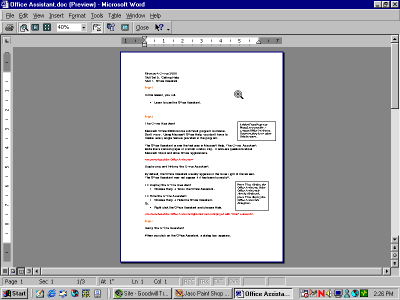
Office 2000 Basics
Introduction
By the end of this lesson, you should be able to:
- Learn Print Preview
- Learn Page Setup
- Learn to print
Print Preview
The key components of Office 2000 are Word, Excel, PowerPoint, and Access. We will focus on these four applications throughout the Office 2000 skill sets.
Print Preview allows you to see how your file looks before you print, preventing a waste of paper and ink.
To access Print Preview:
![]() Choose File
Choose File![]() Print Preview from the menu bar.
Print Preview from the menu bar.

Or use the toolbar:
![]() Click the Print Preview button
Click the Print Preview button ![]() on the Standard toolbar.
on the Standard toolbar.
Once you have accessed Print Preview, your document will now be in Print Preview mode. It will look something like this:

Print Preview mode displays how your file is formatted. If you would like to take a closer look, use the Zoom feature. The Zoom feature zooms closer, giving you a better view of your file.
Important: Print Preview is available in Word, Excel, and Access 2000. It is not available in PowerPoint. See our PowerPoint lessons for more details.
The Print Preview toolbar
Let's zoom in and take a look at the Print Preview toolbar:

- The Print button prints a file.
- The View Ruler button displays the vertical or horizontal rulers. Rulers help edit margin settings.
- If your file consists of multiple pages, the Multiple Pages button allows you to either view one page or several pages at a time.
- Use Zoom, then use the scroll bars to view your file.
- Use the Shrink to Fit button to "squish" your information.
- If you want to exit Print Preview, click Close on the Print Preview toolbar.
Defining your pages
Before printing your files, you may want to define your page margins and paper size.
 To define margins:
To define margins:
- Choose File
 Page Setup from the menu bar.
Page Setup from the menu bar. - The Page Setup dialog box appears. It is slightly different in each of the Microsoft Office applications. For now, we will use the Page Setup dialog box in Word.
- Click the Margins tab and click the top, bottom, left, or right boxes to define the margins.
- Click the Paper Size tab, and click inside the Paper Size list box to define the paper size.
 To define paper orientation:
To define paper orientation:
- Portrait orientation prints text so the page is taller than it is wide.
- Landscape orientation prints text so the page is wider than it is tall.
- In Word, this option is available on the Paper Size tab. In Excel, it is on the Page tab. Page Setup is handled a bit differently in PowerPoint and Access.
Printing your work
To print your work:
![]() Choose File
Choose File![]() Print from the menu bar (Ctrl+P).
Print from the menu bar (Ctrl+P).

Or use the toolbar:
![]() Click the Print button
Click the Print button ![]() on the Standard toolbar.
on the Standard toolbar.
![]() The file automatically prints. The Print dialog box will not appear.
The file automatically prints. The Print dialog box will not appear.
The Print dialog box
Print capabilities differ slightly in each of the Office applications. For our purposes, we will display the Print dialog box in Word 2000.

Printer selection:
In the Name drop-down box, the name(s) of your printer(s) will display. When working in an office environment, it is possible that your computer is part of a network that accesses several printers. Make sure you direct your print job to the correct printer.
Page range selection:
The default setting is all. If you want to print only the current page, select the current page radio button. If you want to print only part of a document but it is more than one page, select the Pages radio button and enter the page numbers you would like to print.
Copies selection:
In this section, there is a Number of copies box. The default setting is 1 copy. Manually enter the number you would like to print by highlighting the number and entering the number of copies you would like to print. You can use the up or down arrows to indicate the desired number of copies.
Collate is a default setting. Collate means to put pages in the proper order. If you want to turn off the collating feature, deselect the radio button. This means if you print more than one copy of a document, all of the first pages will be together, then all of the second pages, etc.
Print what section:
You want to print a document, so leave this at the default setting.
Print section:
The default setting is All pages in range. However, in the drop-down box you can select even pages or odd pages if needed. You can also select a range of pages, like pages 3-6 in a long document.
Challenge!
- Open an existing file.
- Change the page orientation.
- Preview your file using Print Preview.
- Print your file.